"How can you get my 6mo old cockatail to stop biting?"
- Jean, Toolady.com


You bought the most adorable, cuddly, sweet cockatiel youíve ever seen. It loves you unconditionally. It snuggles up to
your shoulder, begs for head scratches and follows you around the house. Six months later youíre thinking of renaming it
"Jaws." It fiercely bites you when you try to take it out of the cage. It asks for a head scratch and then immediately
pecks at you. It masturbates on your head and attacks when you remove it. It flies at your face. It acts nice just
around you but bites when others enter the room. And youíre asking, "What happened?"
When Tootsie hit puberty I didnít know what hit me. He suddenly loved my mom and bit me. No one could get him away from
the toaster without being bitten. Instinctively I began to avoid and fear him. Thinking he wanted to breed I bought
him a hen. He shunned her for the toaster. The problem was never really resolved and I ended up turning him into a
breeder. When Alex, my second pet tiel, hit puberty, nothing happened. He was a sweet as ever.
The trick to surviving your birdís adolescence is understanding bird behavior and reacting appropriately. Hopefully this
article can help you turn your little monster back into a sweetheart.
The Baby Stage
Chicks hold their feathers in a particular manner that makes them look especially cuddly. Adults tend to have more
willful control of their plumage. Baby plumage is often softer and nicer. It has not yet been worn from daily wear
and tear. Look at the images below. Both are pictures of my "brat twins." The left image is a baby picture taken during
weaning. The right picture is an image taken after maturity (Well, physical maturity anyway...). Notice how much
sleeker they are later.
For most pet owners when a bird is purchased it is just past the weaning stage. For a lucky few it may be a bit
older and skillfully socialized by a caring handfeeder. In either case the bird is first obtained while in the baby
stage. The baby stage lasts until the bird reaches puberty.Physical and Emotional Characteristics of the Baby Stage
Young birds tend to have poor coordination and motor skills (particularly the larger species). Many psittacines are
slower moving, unsure and downright ungainly, particularly when clipped. African greys are among the worst in this
category. Cockatiels arenít so great either, often taking off backwards and breaking tail feathers. Experts can tell a
baby just by its awkward, deliberate movements. However, not all species are that clumsy. Budgies usually aren't.
Kakarikis are agile fliers at a young age.
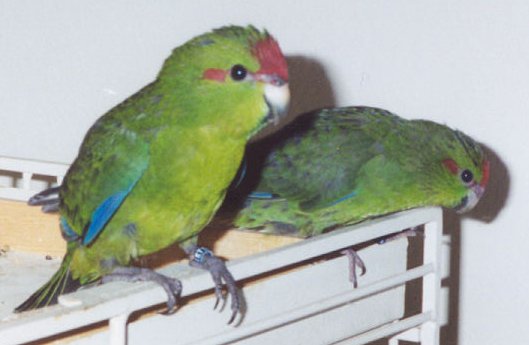

In many species the adult coloration differs from that of the juveniles. Sometimes the adult plumage is drastically different. Male pearl cockatiels will gradually lose all their pearls until they look exactly like regular birds. Male Indian ringnecks get a ring around their neck around 18 months. Green and blue birds get a black ring. Lutinos get a pink one. Albinos display no ring (they have no pigment to make one). Even in nonpsittacine species (like finches and songbirds) chicks can look very different from adults. Many times chicks are dull in color. Males and sometimes females eventually molt into more colorful patterns. Gouldian finch chicks look nothing like the striking beauties they will become.
 In some species the plumage change is more subtle. If you are familiar at all with macaws you'll notice that most species
have white facial skin and several lines of small feathers striping through it. You'll also notice that scarlet macaws
appear to have no feathers in this area. Look closer! As chicks, scarlets have red feathers in this area, just like greenwing
macaws. These feathers are eventually exchanged for white ones, giving scarlet macaws a more bare-faced, wrinkly appearance.
In some species the plumage change is more subtle. If you are familiar at all with macaws you'll notice that most species
have white facial skin and several lines of small feathers striping through it. You'll also notice that scarlet macaws
appear to have no feathers in this area. Look closer! As chicks, scarlets have red feathers in this area, just like greenwing
macaws. These feathers are eventually exchanged for white ones, giving scarlet macaws a more bare-faced, wrinkly appearance.
Budgies too change color with age. You'll notice that budgies have barring on their head and back. In chicks the barring extends to the cere. After the first molt the barring stops at the top of the head. Budgie chicks also start out very pastel and their color will darken greatly over time. In many cases a faint tint may become the predominant color. Look at the picture of Jaz and his daughter. Both are skyblue spangle. Yet Jaz is many shades darker than his daughter (see below).

Chicks many times have unique eye coloring. The eyes may start out one color and change to a
lighter one in adulthood. African greys hatch with dark eyes that later change to yellow. Kakariki chicks have brown eyes
which change to bright orange. Their beaks are also horn-colored tipped in black. Immediately upon weaning their beaks
begin to darken to the typical black-tipped silver coloration.
Babies are usually cuddlier than adults. They are almost always up for a head scratch, kiss or tummy tickle. They beg for scritches and want nothing more than to be with you. Adult birds are different. It's not that they do not enjoy petting as much, it's just that they aren't always in the mood. Human babies are the same way. Parents can kiss, hug and dote on them constantly; babies could care less. As adults we have a better sense of "personal space." Adult birds need their personal space as much as we do. They still enjoy touch, but on their terms. Pushy owners may be bitten if they don't respect their bird's requests to be left alone.
By far the most important thing you need to know about the baby stage is this:
Chicks automatically accept that you are in charge.
What you do during the baby stage can have a huge influence when adolescence hits. Birds are very observant of your behavior and many of the bad habits that birds display as adults are indirectly the result of the owner. Although they start out innocent babies, birds grow up. That is the way of life. Just like humans, what you teach birds during their baby stage can cause harmony or hell when puberty rolls around.
Adolescence
When does puberty hit? It varies from species to species. Iíve seen budgies go through it at three months old. The
smaller the species the sooner it occurs. Cockatiels start around six to nine months. For ringnecks and small conures it
occurs anywhere from one year to two years. Large parrots can take several years to mature. Four years is the breeding
age for the largest parrots, which means that puberty may occur slightly before. Keep in mind that "breeding age" and
"puberty" are two different things.
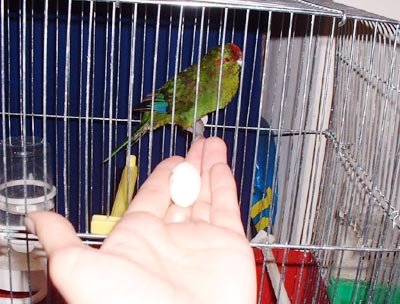 Just because a bird is physically capable of breeding does not mean it is ready for such
a daunting task. Hens in particular are stressed by egg laying and may become egg bound if encouraged to breed at very early
ages. Always double check the standard breeding age before offering a nestbox.
Just because a bird is physically capable of breeding does not mean it is ready for such
a daunting task. Hens in particular are stressed by egg laying and may become egg bound if encouraged to breed at very early
ages. Always double check the standard breeding age before offering a nestbox.
The issue described above is one concerning dominance. Birds do not become dominant overnight. You may notice that your bird has begun nipping or playfully chewing harder than usual. In some cases they may not know their own strength (which is why you should never let babies nibble anything you donít want them chewing later). Many times though this is a test to see what they can get away with. How do you react to their nipping? By reasserting your authority. The "evil eye" and a stern "NO" will usually halt the behavior immediately. You can even talk to them and use a dissapproving tone. Birds are great observers and will pick up on your tone. It is also important to make eye contact when speaking so they know you are talking to them.
Rough play can also encourage nippiness. Chicks are naturally more gentle. By the time play becomes more painful the bird has learned that the behavior is acceptable. Mock wrestling does the opposite of what we want, which is to assert our authority:
| ...this type of interaction should be discouraged as it undermines your standing as a respected parent image and places you more into the category of a sibling companion. This will also allow the bird to believe that it can eventually place you somewhere below it in the pecking order. - Parrots: Handfeeding & Nursery Management by Voren & Jordan |
As a parental figure you remain untouchable. The bird knows you are in charge and won't try very hard to dispute the fact.
If the bird sees you as just any flock member, be it sibling or potential mate, it will begin to battle for supremacy.
Height also factors into dominance, especially with larger species. While it may be okay to have a budgie or cockatiel
on your shoulder, never allow larger species to perch there. The shoulder puts a bird at your eye
level, giving it authority equal to or greater than yours. It also allows birds great access to your face when
they want to bite. I donít care how tame and sweet your pet is, ALL birds can and do
bite. Medium and large
species can cause serious damage. Keep parrots any larger than a tiel on your arm, not your shoulder. Also
keep all cages, perches and playstands lower than your eye level to reaffirm your authority.
The "Up" command, taught by stick training, is a good way to regain control over your bird.
Bites are sometimes the result of a bird being unclear what the owner is asking. Not all people offer their fingers in the
same manner. Even if offered appropriately a bird may still be confused. During puberty a bird may see an approaching
finger as an invasion of territory, potential aggressor or mere annoyance. What's the quickest way to get rid of a finger?
Bite it. When you tell a bird "Up" or "Step Up" while offering a finger you are giving it a clear idea of what you want.
You are not invading or attacking. You are asking it to step up. "Up" is also a command. If a bird refuses to step up
you can put it back in the cage or not allow it out. Once again this tells the bird that you are in control.
Breeding behavior is not a sign that your bird
needs to become a breeder (many times it is YOU they want to mate with). Though some species can be both pets
and breeders (budgies, tiels, Indian ringnecks) most cannot.
Masturbation is a perfectly normal occurrence which is best not encouraged or
discouraged. Only occationally does it become a real problem. I once counseled a man whose newly acquired tiel would
begin masturbating on his head and then bite when removed. He took the bites very personally since the bird seemed to like
him. I had to explain that birds do not necessarily view us as an entire object. Faces are often seen as another
"bird." The body is like a giant mobile perch to them. I donít know what they think hands are. His bird had found a
"nesting" territory (his head) and was only defending his territory against the invading hands. Bites usually have
very rational reasons once seen from the birdís perspective.
Territoriality is often linked to sexual behavior. It is okay for a bird to stake out some territory (perhaps its
cage) but as the authority figure you should be able to access any territory without problems. Some birds may become
increasingly territorial though and threaten you whenever you open the cage, near the playstand,
or reach in to feed. This is acceptable behavior for breeders but not pets. Breeders can be as territorial as they want
to; pets need to coexist. Birds usually form territory due to sexual reasons. Breeders form territory around their
nestbox and will defend it against predators and other birds (competition). In pets this behavior is misplaced. A pet
may feel the desire to breed and form an attachment to a particular toy or human. It may also view certain areas as
potential nesting sites. I recommend removing or covering all such areas. Happy Huts are loved by many birds but can
cause territoriality if viewed as a nesting place. Covered
dishes can also be a problem. Birds may also find dark areas around the household. This is actually dangerous because the
bird may become lost, trapped or squashed if left unsupervised.
Things are a tad more complicated when the territoriality involves a human. The odd person out should make an attempt to
work with the bird alone, out of sight and sound of the favorite human. The "hot potato" method can also help.
This game should include everyone in the household. You sit in a circle and use the "Up" command to slowly pass the bird
around the circle. Favorite persons are not exempt from bites. In many cases, they get more than anyone else! This is
due to the protective nature of birds and their somewhat confused perspective of humans. A favorite person is often viewed
as a mate. When other humans enter the room the bird, usually on a shoulder, begins to attack the object of their
affection. Why? Because they expect you (or your head) to fly away to safety while they take on the danger! My
green-cheek conure did this whenever my mother or a larger group of people came near me. It is important to recognize
behaviors like this and deal with them appropriately. Sometimes just understanding what your bird is really thinking
can help you react better to the problem. If Confetti got too nippy when others were around I could use the "Up" command
to get her off my shoulder and put her back in the cage to settle down.
Unclipped wings contribute to the territory problem. Rather than becoming aggressive over just the cage, the bird may
stake out the entire house as its territory and try to defend it from everyone. Flight also allows birds to perch
above you (dominance by height), fly at your face (dangerous) and fly away from you (giving you NO control over putting
them away). Thereís no excuse here. Clip the wings.
Asserting Your Authority
Chances are if youíre reading this you havenít asserted your authority and are experiencing some serious problems as a
result. Thatís okay; I went through it too. Back then I had no idea how to deal with it. You are lucky enough to have
found this article to guide you. Below is a quick recap of methods you can use.
Ralphie had started singing not long before I first brought him to live with me. When his new girlfriend arrived he was in
the midst of puberty. They got along well but Ralphie started spending all his time in the cage perched in a Happy Hut. A
Happy Hut is a fabric tent manufactured specifically for birds. Conures in particular love the things. They have a
fondness for diving into your shirt, cuddling under your collar and sleeping in their nestboxes year-round. I had
originally bought my Happy Hut for Fry but he ignored it. I then gave it to Jay-Jay, who absolutely loved it. But because
she was a sun conure (see LOUD) I had to evict her from my apartment before someone evicted me. Ralphie was
now in Jay-Jayís old cage, which still contained the Happy Hut. He loved to sing in it and masturbate on it. Unlike
Jay-Jay, whoíd immediately bolt out once I opened the cage, Ralphie had to be removed by hand.
Because he was going through puberty Ralphie became territorial with me, but only mildy so. Heíd mock bite or peck if I
invaded his territory. His threats were only a display though. Ralphie knew I was in charge and only pecked to
show his displeasure. If he was being especially pesky with me Iíd firmly tell him to knock it off and he would. Like
many adolescent birds, he did not welcome physical affection. If I picked him up and kissed him on the head heíd protest.
Only once or twice during this period did he ever actually nip me. Iíd immediately reprimand him with a stern
"NO" and put him back in the cage. He knew that wasnít allowed.
The real trouble began about a month after Iíd brought Lana (the yellowface) home. Ralphie began attacking her around
the hut. At first it was just mild territoriality and heíd leave her alone if she stayed away from it. Then one day
when I placed them in the cage as I was leaving for work, he began chasing and nipping her all over the cage. The poor girl
couldnít go anywhere without be attacked! Unlike his behavior with me, he actually bit her. I had to separate him
into a smaller cage when I was out of the house.
Finally I decided to remove the Happy Hut. Ralphie was a bit disappointed at first but his behavior immediately
improved. With the Happy Hut gone there was nothing to be territorial over. Lana could perch anywhere in the cage without
being attacked. He also lightened up a bit with me. In fact, as soon as I removed the hut he showed almost no signs of being an
adolescent at all. Within a few days he was back to being a sweety.
Ralphie is currently about a year old and done with puberty. Lana is still in the "baby stage." Ralphie struts about the
playgym and sings, loves kisses again and preens Lana, who still hasnít figured out sheís supposed to preen him
back.
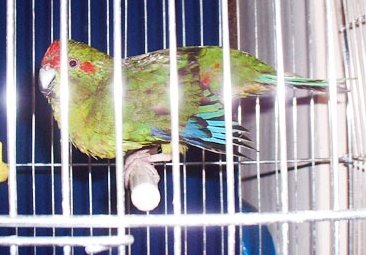 Sexual behaviors begin at puberty. There is a wide range of sexual behaviors that birds can exhibit. Male
cockatiels usually begin whistling at puberty. They strut about and sing. Amazons will display, fluff up and generally
look very cute to the unwary owner. If you approach them during such a display youíll get bitten. Both males and
females will regurgitate to their "mates." If this happens to you, itís a huge compliment!
Females may also begin to lay eggs.
Sexual behaviors begin at puberty. There is a wide range of sexual behaviors that birds can exhibit. Male
cockatiels usually begin whistling at puberty. They strut about and sing. Amazons will display, fluff up and generally
look very cute to the unwary owner. If you approach them during such a display youíll get bitten. Both males and
females will regurgitate to their "mates." If this happens to you, itís a huge compliment!
Females may also begin to lay eggs.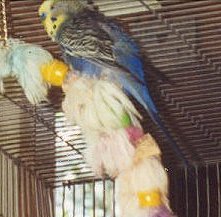 Usually birds masturbate with a favorite item (toy, perch, bird buddy, human hand/arm/head). Males do so by mounting
the object and vigorously rubbing the cloaca on it. Hens also rub but tend to back into things rather than mount them. They
also get excited when pet on the back because it simulates a male mounting. If your hen does this try to inch back up to
petting the head rather than the back.
Usually birds masturbate with a favorite item (toy, perch, bird buddy, human hand/arm/head). Males do so by mounting
the object and vigorously rubbing the cloaca on it. Hens also rub but tend to back into things rather than mount them. They
also get excited when pet on the back because it simulates a male mounting. If your hen does this try to inch back up to
petting the head rather than the back.
Every time I help someone during this stage I wind up giving them a pep talk. Are you going to let an 80 gram cockatiel
push you around? I've found that one of the best preventative measures for problems during adolescence is knowing and
acting like you are in charge. If you do this well enough from the very beginning when you obtain a bird you may not even
notice any changes when it goes through puberty. If you do experience a little birdie attitude it will be much
milder. Instead of biting outright your bird may mock bite, fluff up, bite air or a perch to display disapproval. The
bird knows you are the boss.Methods for Regaining Authority
Other Methods I Don't Encourage and Why
Ralphie and the Happy Hut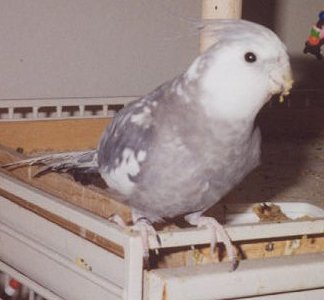 Ralphie Boy was like all of my handfed tiels- a complete sweety. After weaning, I placed him in one of my flights. Every
time I walked in he was all over me, begging to be pet and coddled. I didnít have the heart to sell the little guy (that
seems to happen too often with my handfeds, Iím such a sucker) and ended up bringing him back to my apartment to live with
me. I also brought along Melonie, my oldest cockatiel. She had lost her mate Tootsie in 1999. I was hoping Ralphie would
charm her as much as he charmed me. Alas, they didnít hit it off. Outside the cage they never stayed near one another and
I never saw them mutual preen. Eventually I put Melonie back in the aviary, where she paired up with a one-footed male.
They are now breeding.
Ralphie Boy was like all of my handfed tiels- a complete sweety. After weaning, I placed him in one of my flights. Every
time I walked in he was all over me, begging to be pet and coddled. I didnít have the heart to sell the little guy (that
seems to happen too often with my handfeds, Iím such a sucker) and ended up bringing him back to my apartment to live with
me. I also brought along Melonie, my oldest cockatiel. She had lost her mate Tootsie in 1999. I was hoping Ralphie would
charm her as much as he charmed me. Alas, they didnít hit it off. Outside the cage they never stayed near one another and
I never saw them mutual preen. Eventually I put Melonie back in the aviary, where she paired up with a one-footed male.
They are now breeding.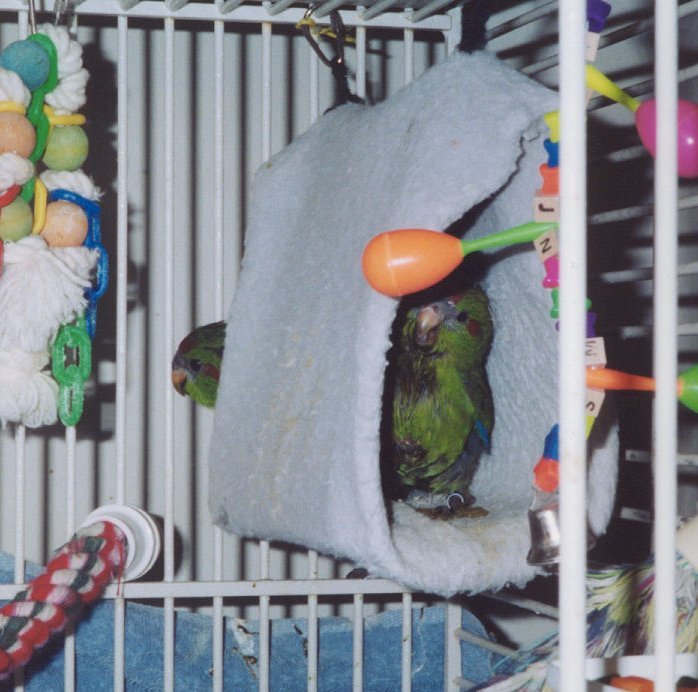 The August bird mart was a bust. Everyone was buying supplies and no one was buying birds. Towards the end of the mart I
bumped into a woman with a handfed yellowface tiel for sale. It appeared to be in good health and fairly-well socialized.
She was also cinnamon pearl, split to whiteface and pied. When I saw her I immediately thought of Ralphie. Heís a
whiteface pearl, split to pied and cinnamon. Theyíd make a decent match. The breeder obviously cared about her birds.
She knew the genetic makeup of her stock and was concerned over what type of home her birds would be going to. Remember,
the seller should play an important role in your decision to buy. Most of you readers
agreed with me. I purchased her for only $80, a very good price considering it was handfed and
yellowfaces were running over $150 at the time.
The August bird mart was a bust. Everyone was buying supplies and no one was buying birds. Towards the end of the mart I
bumped into a woman with a handfed yellowface tiel for sale. It appeared to be in good health and fairly-well socialized.
She was also cinnamon pearl, split to whiteface and pied. When I saw her I immediately thought of Ralphie. Heís a
whiteface pearl, split to pied and cinnamon. Theyíd make a decent match. The breeder obviously cared about her birds.
She knew the genetic makeup of her stock and was concerned over what type of home her birds would be going to. Remember,
the seller should play an important role in your decision to buy. Most of you readers
agreed with me. I purchased her for only $80, a very good price considering it was handfed and
yellowfaces were running over $150 at the time.
I've only scratched the surface on this topic. If you'd like to read more please visit the links below. Most of them
are articles by Liz Wilson and Sally Blanchard, professional behavior consultants. Remember, understanding bird behavior is
the key to preventing problems!
Books and Magazines on Behavior
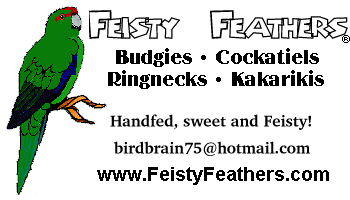
Special thanks to Aida for the pics of Luca. =) Articles and images contained on this site are © 1997-2002 by Karen Trinkaus unless otherwise noted and may not be reprinted or used in any way without the author's permission.